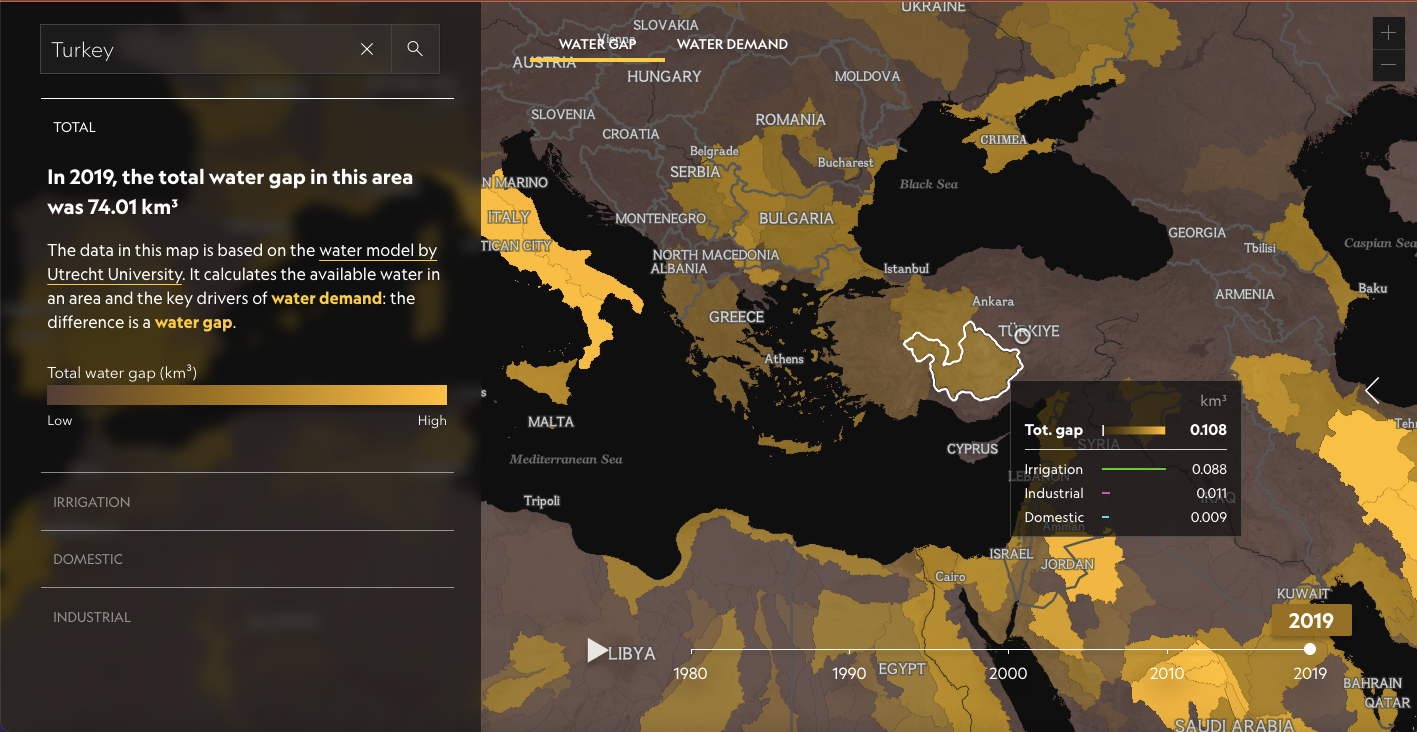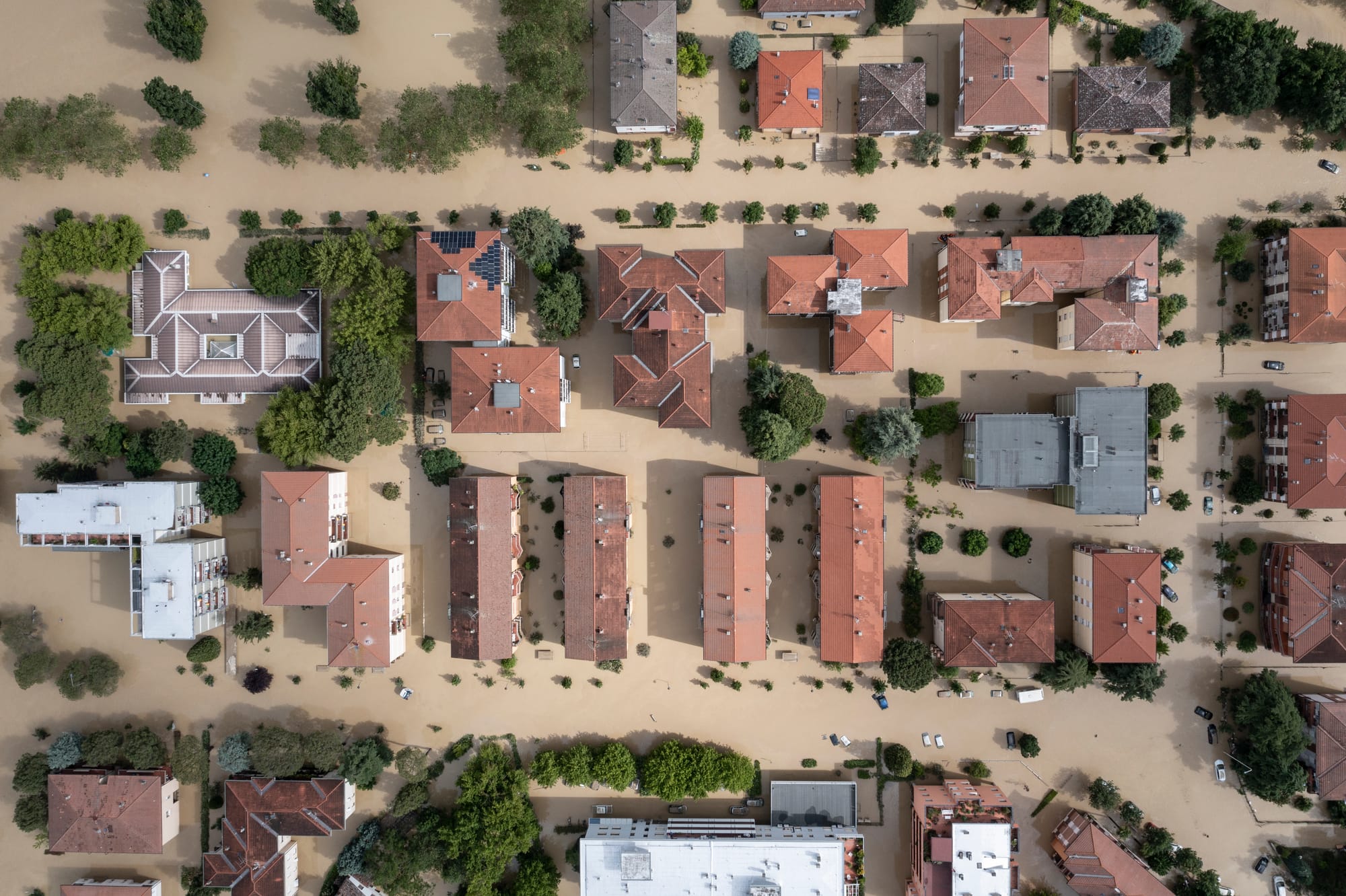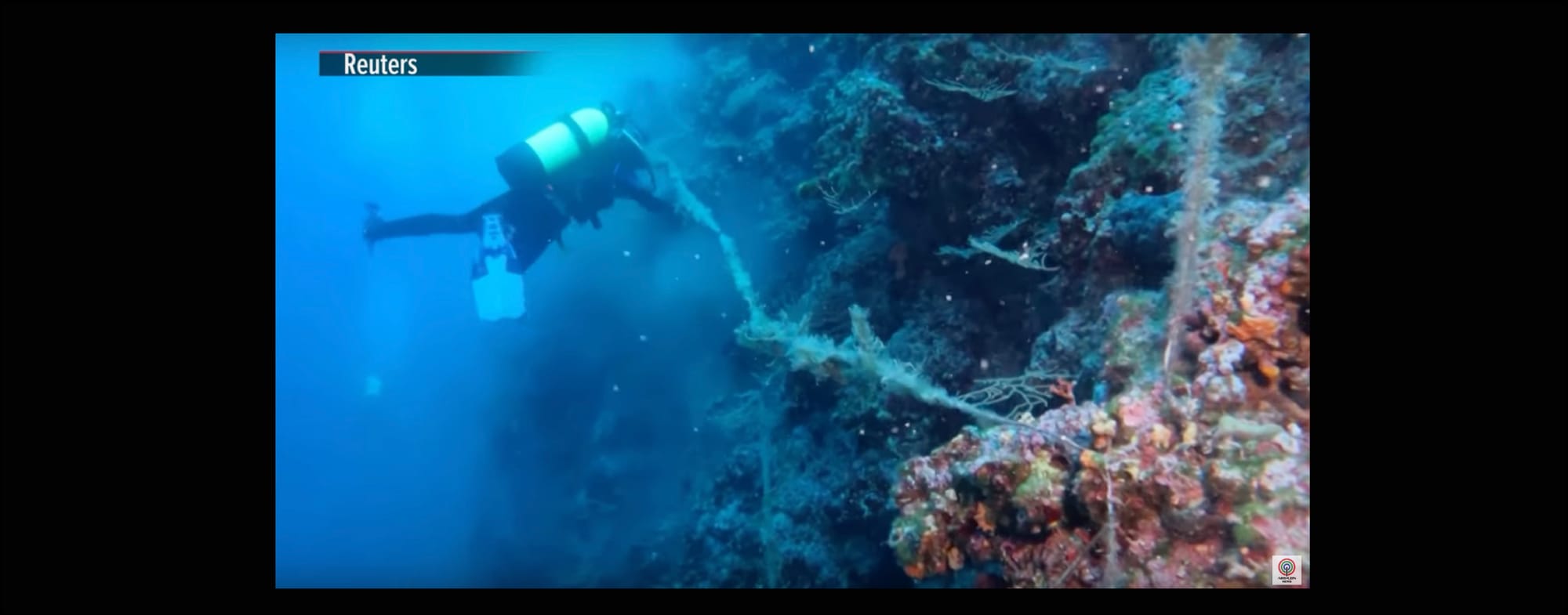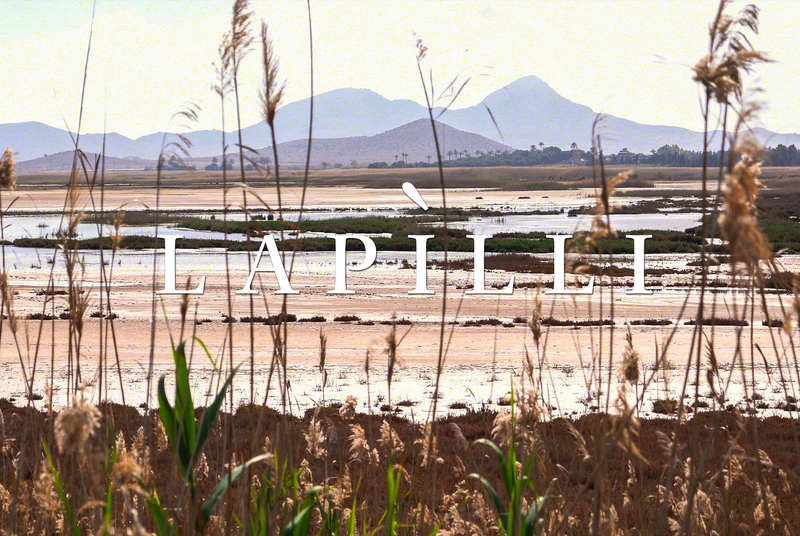This month’s Lapilli is mostly about heat, water and Mediterranean marine life, such as monk seals, Cuvier's beaked and sperm whales. Alongside a sneak peek into the upcoming summer temperatures, you’ll read about the severe drought that continues affecting southern Italy, Mediterranean hotspots where water demand exceeds water availability, as well as water bodies in central Italy and Spain that are suffocating due to an excessive use of fertilizers. This issue also features a recent study suggesting that April’s heatwave in West Asia may have exacerbated the already dramatic humanitarian conditions in the Gaza Strip and an interactive story about megafires in southern Europe. Finally, on a more positive note, we highlight an initiative in Croatia aimed at preserving marine life. We hope you enjoy this edition. If you do, please consider sharing it with your friends, relatives or colleagues!

The upcoming summer. The models speak clearly, this summer in Europe, the fastest-warming region of the world, will be extremely hot as it has been for many recent summers already. Experts interviewed by the New York Times say the hottest temperatures will occur in late July and August, especially in Croatia, Italy and Greece. And it is precisely for this reason that Athens appointed a “chief heat officer,” Elissavet Bargianni, in 2021. She is in charge of coordinating measures to prevent discomfort and deaths from extreme heat, especially of the most vulnerable populations, such as children and the elderly. Interviewed by Euronews immediately after her appointment, Bargianni explained that, in the future, heatwaves will be increasingly recurrent, that we need to prepare and do everything possible to redesign cities — which get hotter than less developed locations because of the urban heat island effect — and make them as cool and livable as possible.
To get an idea of the accelerating rise in temperatures, just consider that the summer of 2022 was the hottest summer in Europe since temperatures have been recorded. And the summer of 2023 was the hottest in the Northern Hemisphere in 2,000 years, according to a recent study that extracted this data by looking at tree rings more than 2,000 years old (Scientific American).
The ongoing Sicilian drought. We've already mentioned the severe drought conditions affecting Sicily, Italy, in previous issues. Unfortunately, the situation hasn't improved. Fields and pastures are dry, especially on the inner part of the island. Farmers are struggling to feed their livestock. Hay is lacking. Italy's farmers' union and other trade associations have intervened to alleviate the situation, sending 3.3 pounds of hay to Sicilian farmers (Domani; Euronews Green).
In addition to experiencing the effects of climate change, Sicily is also grappling with chronic deficiencies in its water network infrastructure. The limited water supply is either lost or poorly managed. According to Istat, and as reported in a recent story by freelance journalist Pierluigi Bizzini on EUobserver, over 52 percent of the water that entered the island's water supply network was lost in 2020. Bizzini also reports on the challenges in implementing planned infrastructure and utilizing available funds, as well as the lack of a systemic approach that also includes the renaturalization of rivers, lagoons and wetlands (EUobserver).

Rare occurrences. Also in Sicily, but closer to the coast — specifically in the marine protected area of Plemmirio, near Syracuse — a rare individual of the Mediterranean monk seal made its appearance. Two years ago, one was noticed in the same area for the first time in 60 years. Monk seals used to be widespread in the Mediterranean but their population has shrunk more and more owing to habitat loss, tourism and fishermen’s deliberate killings. The species is highly endangered; there are only about 700 individuals between the Mediterranean and the eastern Atlantic (Siracusa News).
Over 700 miles north, between Corsica and Elba Island, four Cuvier’s beaked whales were found beached within a few days. Three of them died. We know very little about these cetaceans because they are rare and capable of diving to great depths for a long time, so it is not easy to spot them. However, these beachings are suspicious as they are concentrated in a small area and occurred within a few days of each other. Pending autopsy results, the most popular theory is that NATO military exercises in the region might have frightened the animals, causing them to surface too quickly and suffer fatal air embolisms (Fanpage.it; Francebleu.fr).

The long journey of a sperm whale. A team of researchers from the University of Exeter in the U.K. and the University of Haifa in Israel, along with Greenpeace, tracked a sperm whale across the Mediterranean Sea, from the Ligurian Sea to the coast of Israel. This is the longest journey ever recorded of a sperm whale. The study shows how these whales navigate the Mediterranean, passing through heavily trafficked areas, such as the Strait of Messina and the Strait of Sicily — both of which are among the busiest areas in one of the world's most heavily trafficked seas. The research highlights the need for conservation measures, such as installing hydrophones in high-traffic zones with offshore hydrocarbon exploration, to alert people to the whales' presence and ensure their protection (Sciencedaily).
Water gaps in the Mediterranean. A recent study in Environmental Research Letters identified 21 hotspots where water demand exceeds water availability. Five of these hotspots are in the Mediterranean region: Spain, Italy, Greece, Turkey and the Nile Delta (Egypt). According to researchers at Utrecht University in the Netherlands, high agricultural water use is the main driver of water scarcity in most of these Mediterranean hotspots. However, for Spain, researchers highlight something distinct. Along with parts of Chile, Australia and Japan, the water gap in the Iberian country is mainly driven by hydroclimatic changes, more specifically a declining total annual rainfall. The authors of the study define the water gap as the difference between human demand and water availability from rivers, lakes and shallow aquifers refreshed by rain. If persistent, such a water gap depletes freshwater resources. In this interactive map — which the National Geographic Society has created in partnership with Utrecht University and Esri as part of its Freshwater Initiative — it is possible to explore the situation across the planet and how water use has changed throughout recent history.

Similarly, a recent journalism project has looked into the state of Europe’s groundwater. Analyzing the available data, 14 journalists from seven countries coordinated by Arena for Journalism in Europe found out that more than 15 percent of the considered aquifers are considered dangerously overexploited, contaminated or both, with those in Spain, France, Belgium and the Netherlands being the worst affected (Under the Surface).

Oxygen-depleted waters. Thanks to synthetic fertilizers, we have been able to produce an abundance of food over the past century, enabling the post-World War II "Green Revolution." However, a significant portion of these fertilizers is not absorbed by plants and remains in the surrounding environment, disrupting ecological balances. An investigation by Magma's members Marcello Rossi and Davide Mancini takes us to Tuscia, in central Italy, and the Mar Menor, in Spain, where decades of fertilizer use have depleted the oxygen in the surrounding water bodies. This issue, as it pertains to Europe, is summarized in a video on Domani (in Spanish with Italian subtitles), or you can read about it in English on EUobserver and in Spanish on Climatica.
This month’s cover is a shot taken in the Mar Menor area. It depicts the wetland distancing the cultivated fields from the salt lagoon, receiving and filtering a good portion of the fertilizer-laden waters (Davide Mancini).

Extreme heatwave hits Gaza. In April, an exceptional heatwave hit the Gaza Strip, exacerbating the already dire humanitarian crisis caused by the ongoing conflict. A new analysis by the World Weather Attribution (WWA) indicates that this extreme event was intensified by human-induced climate change.
The WWA study examined heatwaves in three areas: West Asia, the Philippines and South and Southeast Asia. In West Asia — including Palestine, Syria, Lebanon, Israel and Jordan — temperatures soared above 40 degrees Celsius (104 Fahrenheit). Climate change has made this heat about five times more likely to occur and 1.7 degrees Celsius (3.06 Fahrenheit) hotter than in the past. In Gaza, the heatwave severely impacted 1.7 million people, who are already suffering from limited access to water and inadequate medical care.
To assess the impact of climate change on extreme heat, WWA researchers compared the current climate, which is about 1.2 degrees Celsius (2.16 Fahrenheit) warmer than the pre-industrial era, with past climate data. According to Friederike Otto, a lecturer in climate science at the Grantham Institute for Climate Change and the Environment and an author of the report: “Heatwaves have always happened. But the additional heat, driven by emissions from oil, gas and coal, is resulting in death for many people.”
Extreme heatwaves, like those in Gaza, are not uncommon and occur about once every 10 years. However, if the global average temperature rises by 2 degrees Celsius (3.6 Fahrenheit) above the pre-industrial levels, similar events could happen once every five years in West Asia (CNN).
Southern Europe's fire belt. El Diario published an interactive map (with text in Spanish) showing the megafires that have hit the Mediterranean area in recent years. Starting off up north in Evros region of Greece, the map depicts the biggest blaze to hit Europe since 2023. The fire lasted for 16 days and resulted in 20 fatalities. It rapidly expanded throughout the Alexandroupolis area, consuming nearly 100,000 hectares due to prevailing strong winds and intense temperatures.
Big fires pose a real danger to European forests. Each red circle on the map represents a wildfire that set more than 500 hectares ablaze dating back to 2000. Most of the wildfires occurred in Portugal, Spain and Greece, forming a belt across the entire south of Europe, as shown by the Fire Weather Index (FWI). Projections suggest a 20 to 40 percent rise in wildfire-prone days by the end of the century in Spain, Italy and Greece.
These fires often become “unstoppable” owing to the combination of high temperatures and strong winds. Additionally, they can generate phenomena such as fire tornadoes. Approximately, 57 percent of the eight million hectares affected by significant fires between 2000 and 2023 have been consumed by these fires. The article delves further into the subject matter, providing detailed analysis accompanied by photographs, maps and narratives, focusing on the regions impacted by three of the most severe megafires in Greece, Spain and Portugal (El Diario).

One year after the Emilia-Romagna floods. In the latest Lapilli+, photojournalist Michele Lapini recounted his year-long experience returning to the areas devastated by the floods that hit Emilia-Romagna in May 2023. Above all, he has particularly focused his account on underreported aspects, such as the landslides and ongoing challenges many hill and mountain areas are still facing, the floods’ impact on people's identities and the disrupted sense of community resulting from a changing landscape. If you haven't read it yet, you can find it here (feel free to reply to this email to request the full version or switch to Lapilli Premium to read it on our website). We also highly recommend checking out Lapini's project, FRAGILE.

Removing ghost gear off Croatia. We want to say goodbye with this video from Molat Island, Croatia. Here, a group of divers removed more than 440 pounds of ghost fishing gear from the waters surrounding the Zadar archipelago, which in part belongs to the EU's environmentally protected Natura 2000 network. This three-year initiative, which started in 2023, aims to address the threat that lost or abandoned fishing gear continues to pose to marine life.


MAGMA
At Magma, we are committed to reporting on the ways climate change is transforming the Mediterranean region. We currently do so mostly through Lapilli, a monthly newsletter written in Italian and English, that has a free and premium version. Find out who we are and read our manifesto.That's it for this month. Thank you for reading this far. See you in July or earlier with Lapilli+.
If this newsletter was forwarded to you, you can subscribe here to continue receiving it. Lapilli is free and always will be, but in case you would like to buy us a coffee or make a small donation, you can do so here. Thank you!
Lapilli is the newsletter that collects monthly news and insights on the environment and the Mediterranean, seen in the media and selected by Magma.

